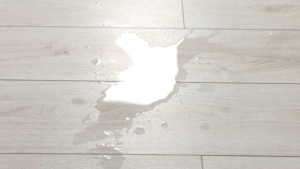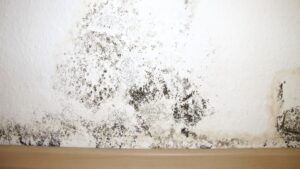A type of fungus, mold grows in the form of multicellular filaments called hyphae that help it break down and absorb nutrients. Hyphal growth results in discoloration and lends a fuzzy appearance (especially when mold grows on food). The network of tubular branching hyphae is called a mycelium. It is considered a single organism. There are several taxonomically diverse types of mold. If you notice mold growing on the surfaces in your home, schedule mold remediation near me in Lake County immediately.
Some Common Types of Mold
Some types of mold commonly found in residential and commercial properties include
- Aspergillus: Usually grows in heating and air conditioning systems. It has a flat, fuzzy texture and can produce mycotoxins. Aspergillus colonies are different shades of white, yellow, and green
- Cladosporium: Typically grows on decaying plants and wooden materials, and surfaces in buildings. It can trigger asthma flare-ups
- Alternaria: Commonly found in soil, plants, and food, Alternaria can trigger asthma attacks in susceptible individuals
- Stachybotrys: Is often called black mold. Like other types of mold, it grows in wet and damp areas. Stachybotrys can produce mycotoxins that may cause health problems
- Mucor: Often found in soil, plant surfaces, rotten vegetable matter, and animal dung. Indoors, it can grow in HVAC systems. If a person with mold allergy inhales a large number of mucor spores, they can experience allergy symptoms
- Acremonium: Grows in humidifiers, cooling coils, drain pans, and window sealants. It can cause disease in immunocompromised people
Ignoring Mold Could Prove to be a Costly Problem
Molds reproduce (either sexually or asexually) by producing small spores, which may contain a single nucleus. They can spread through air, water, or on animals and can cause biodegradation of natural materials. Some types of mold produce mycotoxins, which can pose serious health risks. Prolonged exposure to high levels of these toxic compounds can cause neurological problems and, in some cases, death.
Mold is everywhere. At low levels, it may not cause any problems, however, if you inhale a large number of mold spores, you could experience health problems (especially if you’re sensitive to mold or have a seasonal allergy)
Here are some ways in which mold can affect human health.
- Respiratory problems: Exposure to mold can cause symptoms such as sneezing, coughing, wheezing, watery eyes, and itchy skin. In people with chronic lung illnesses, mold may cause lung infections
- Allergic reactions: In people who are allergic to mold, exposure to mold spores can cause skin rashes, red eyes, and a runny nose. Sometimes exposure to a large number of mold spores can cause a severe allergic reaction called hypersensitivity pneumonitis
- Mold is an asthma trigger: In people with asthma, mold can trigger asthma attacks. If you have asthma and inhale a large number of mold spores regularly, your symptoms can get worse
- Long-term effects of mold exposure: Some types of mold including Stachybotrys chartarum (commonly known as black mold), produce toxins known as mycotoxins. Various studies have linked prolonged exposure to high levels of mycotoxins to neurological problems and, in rare cases, death. However, it’s important to note that not all black molds produce mycotoxins and not all types of mycotoxins are produced by black molds.
Other Potential Consequences of Unchecked Mold Growth
In addition to causing health problems, different types of mold can impact the structural integrity of buildings. It feeds on organic materials including wood, ceiling tiles, and drywall, causing them to decay and weaken. Mold can also cause damage to your items such as furniture, carpets, and personal belongings. It often produces a musty, unpleasant odor, which can permeate a home or building.
It’s important to address mold problems promptly and effectively, and to take steps to prevent mold growth in homes and buildings. To keep mold from gaining a foothold in your building, perform regular maintenance, ensure your bathroom, kitchen, basement, and crawlspace are properly ventilated, control humidity levels in your building, and promptly fix water leaks.
How Does Mold Grow?
Mold growth is a common issue in warm, damp, and humid environments. By developing an understanding of how mold grows and spreads, you can identify the steps to prevent it and deal with it (if mold appears). Here are some key points about mold growth:
Here’s a basic explanation of how mold grows:
- Favorable conditions for mold growth: Mold requires moisture, a food source (can be wood, paper, carpet, food, or insulation), and suitable temperatures to grow. Some common places in buildings where mold grows include bathrooms, kitchens, basements, or any other damp areas (especially when dampness is caused by a leak or condensation)
- Germination and growth: Once mold spores land on a damp surface, mold starts to grow in the form of hyphae, which are tiny filaments that spread across the surface. As hyphae grow and branch, they form a network known as a mycelium
- Reproduction: As mold grows, it can produce spores on the ends of its hyphae. These spores can then be released into the air to be carried to new locations where they can germinate and develop into a new hyphae cell (and the process occurs all over again)
- Spread: Mold can spread rapidly under the right conditions. It can cover surfaces and penetrate porous materials. Unchecked mold can be very difficult to get rid of
How can West Coast Fire & Water Help?
At West Coast Fire & Water, we are committed to helping property owners maintain healthy, mold-free environments at their properties. Whatever the nature and extent of the mold problem you’re trying to deal with, we can help. Our experts are equipped to manage the complexities of mold remediation near me in Lake County. They have an in-depth understanding of mold remediation guidelines and know the right way to kill mold, so it does not come back after mold remediation near me in Lake County.
To request an estimate, call 707-462-5326.

Marketing Director, West Coast Fire & Water
Christian Ahlmann is the Marketing Director at West Coast Fire & Water, a California restoration company providing water, fire, mold, biohazard, storm, and reconstruction services across multiple locations. He leads brand, content, and demand programs that support rapid response and customer education. His background blends operational storytelling, community engagement, and crisis communications.



